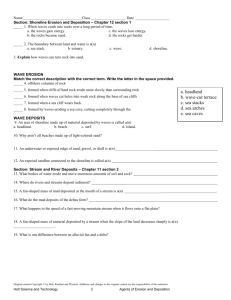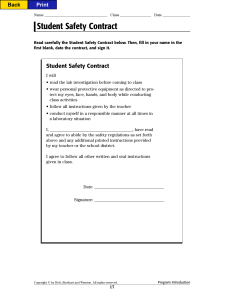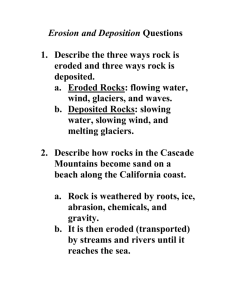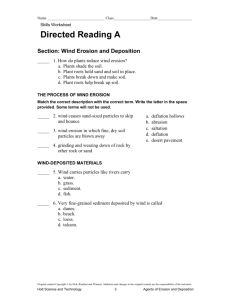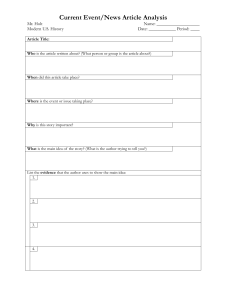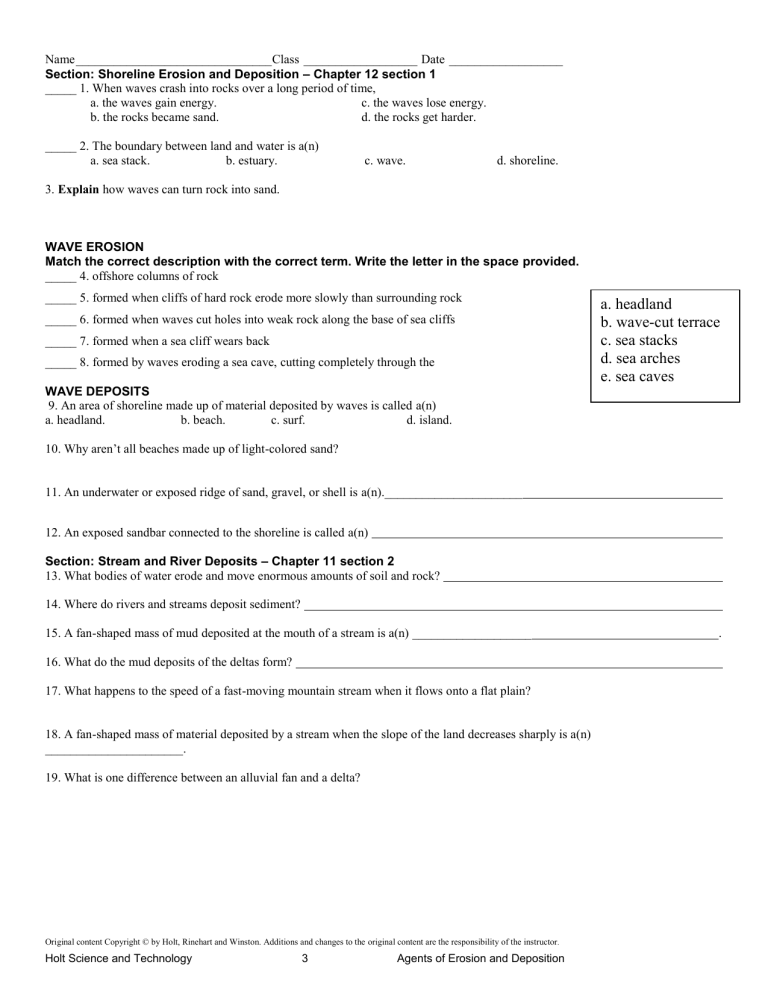
Name _______________________________Class __________________ Date __________________ Section: Shoreline Erosion and Deposition – Chapter 12 section 1 _____ 1. When waves crash into rocks over a long period of time, a. the waves gain energy. c. the waves lose energy. b. the rocks became sand. d. the rocks get harder. _____ 2. The boundary between land and water is a(n) a. sea stack. b. estuary. c. wave. d. shoreline. 3. Explain how waves can turn rock into sand. WAVE EROSION Match the correct description with the correct term. Write the letter in the space provided. _____ 4. offshore columns of rock _____ 5. formed when cliffs of hard rock erode more slowly than surrounding rock _____ 6. formed when waves cut holes into weak rock along the base of sea cliffs _____ 7. formed when a sea cliff wears back _____ 8. formed by waves eroding a sea cave, cutting completely through the a. headland b. wave-cut terrace c. sea stacks d. sea arches e. sea caves WAVE DEPOSITS 9. An area of shoreline made up of material deposited by waves is called a(n) a. headland. b. beach. c. surf. d. island. 10. Why aren’t all beaches made up of light-colored sand? 11. An underwater or exposed ridge of sand, gravel, or shell is a(n).______________________ 12. An exposed sandbar connected to the shoreline is called a(n) Section: Stream and River Deposits – Chapter 11 section 2 13. What bodies of water erode and move enormous amounts of soil and rock? 14. Where do rivers and streams deposit sediment? 15. A fan-shaped mass of mud deposited at the mouth of a stream is a(n) ___________________ 16. What do the mud deposits of the deltas form? 17. What happens to the speed of a fast-moving mountain stream when it flows onto a flat plain? 18. A fan-shaped mass of material deposited by a stream when the slope of the land decreases sharply is a(n) ______________________. 19. What is one difference between an alluvial fan and a delta? Original content Copyright © by Holt, Rinehart and Winston. Additions and changes to the original content are the responsibility of the instructor. Holt Science and Technology 3 Agents of Erosion and Deposition . Name _______________________________Class __________________ Date __________________ Section: Wind Erosion and Deposition _____ 1. How do plants reduce wind erosion? a. Plants shade the soil. b. Plant roots hold sand and soil in place.. c. Plants break down and make soil d. Plant roots help break up soil. THE PROCESS OF WIND EROSION Match the correct description with the correct term. Write the letter in the space provided. Some terms will not be used. _____ 2. wind causes sand-sized particles to skip and bounce _____ 3. wind erosion in which fine, dry soil particles are blown away _____ 4. grinding and wearing down of rock by other rock or sand a. b. c. d. e. deflation hollows abrasion saltation deflation desert pavement Wind-Deposited Materials _____ 5. Wind carries particles like rivers carry a. water. c. sediment b. grass.. d. fish. _____ 6. Very fine-grained sediment deposited by wind is called a. dunes. c. loess b. beach.. d. talcum. Place the five steps involved in forming a sand dune in order from first to last. Write the appropriate number in the space provided. _____ 7. Material collects and creates an additional obstacle. _____ 8. Wind deposits more material, forming a mound or dune. _____ 9. Slowing wind drops the heavier particles. _____ 10. Wind hits a rock, plant, or other object and slows down. _____ 11. The original object eventually becomes buried. Original content Copyright © by Holt, Rinehart and Winston. Additions and changes to the original content are the responsibility of the instructor. Holt Science and Technology 4 Agents of Erosion and Deposition Name _______________________________Class __________________ Date __________________ Section: Erosion and Deposition by Ice 1. What is a glacier? 2. How and where are valley glaciers formed? 3. What type of glacier forms in mountain areas? 4. What is a continental glacier? 5.Describe the two ways glaciers move. LANDFORMS CARVED BY GLACIERS Match the correct description with the correct term. Write the letter in the space provided. _____ 6. smaller glacial valleys that join the deeper main valley _____ 7. bowl-like depressions where glacial ice cuts into the mountain walls _____ 8. pyramid-shaped peaks that form when three or more cirque glaciers erode a mountain _____ 9. jagged ridges that form between two or more cirques cutting into the same mountain a. b. c. d. e. horns hanging valleys arêtes cirques U-shaped valleys _____ 10. valleys formed when a glacier erodes a river valley from its original V shape TYPES OF GLACIAL DEPOSITS 11. All material carried and deposited by glaciers is called ______________________. 12. What are the two main types of glacial drift? 13. Unsorted rock material that is deposited directly by the ice when it melts is called_________________ 14. A glacial deposit that is sorted and layered by streams or melt water is called______________________ Original content Copyright © by Holt, Rinehart and Winston. Additions and changes to the original content are the responsibility of the instructor. Holt Science and Technology 5 Agents of Erosion and Deposition Name _______________________________Class __________________ Date __________________ Section: The Effect of Gravity on Erosion and Deposition 1. What is mass movement? 2.What causes ice, rocks, and soil to move down a slope? RAPID MASS MOVEMENT Match the correct definition with the correct term. Write the letter in the space provided. Some terms will not be used. _____ 3. a group of loose rocks falling down a steep slope _____ 4. sudden, rapid movement of rock and soil down a slope _____ 5. mudflows of volcanic origin _____ 6. rapid movement of a large mass of mud SLOW MASS MOVEMENT _____ 7. Extremely slow movement of material downhill is called a. slump. b. rock fall. c. creep. d. mudflow. 8. What are three factors that affect creep? _______________________________________________________________ _______________________________________________________________ _______________________________________________________________ Original content Copyright © by Holt, Rinehart and Winston. Additions and changes to the original content are the responsibility of the instructor. Holt Science and Technology 6 Agents of Erosion and Deposition a. b. c. d. e. f. landslide slump mudflow lahar rock fall monsoon Name _______________________________Class __________________ Date __________________ Original content Copyright © by Holt, Rinehart and Winston. Additions and changes to the original content are the responsibility of the instructor. Holt Science and Technology 7 Agents of Erosion and Deposition
